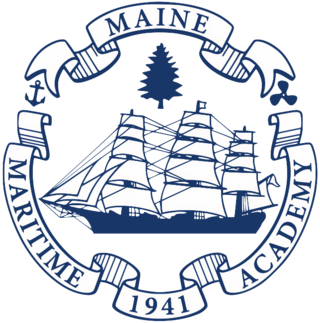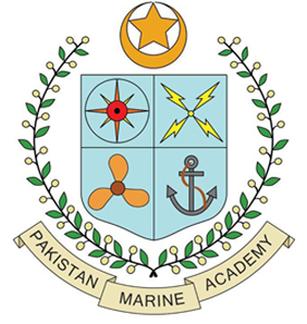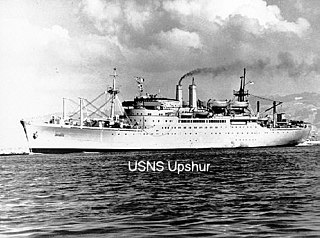
The fifth USS Enterprise, a barque-rigged screw sloop, was launched 13 June 1874 at Portsmouth Navy Yard, Kittery, Maine, US, by John W. Griffiths, a private contractor; and commissioned 16 March 1877, Commander George C. Remey in command. She was later commanded by Bowman H. McCalla around 1890, followed by Commander Albert S. Barker from 1892 to 1896.

The United States Merchant Marine Academy is a United States service academy in Kings Point, New York. It trains its midshipmen to serve as officers in the United States Merchant Marine, branches of the United States Armed Forces and the transportation industry. Midshipmen are trained in different fields such as marine engineering, navigation, ship's administration, maritime law, personnel management, international law, customs, and many other subjects important to the task of running a large ship.

State University of New York Maritime College is a public maritime college in the Bronx, New York City. It is part of the State University of New York (SUNY) system. Founded in 1874, the SUNY Maritime College was the first college of its kind to be founded in the United States and is one of only seven degree-granting maritime academies in the United States.

A training ship is a ship used to train students as sailors. The term is mostly used to describe ships employed by navies to train future officers. Essentially there are two types: those used for training at sea and old hulks used to house classrooms. As with receiving ships or accommodation ships, which were often hulked warships in the 19th Century, when used to bear on their books the shore personnel of a naval station, that were generally replaced by shore facilities commissioned as stone frigates, most "Training Ships" of the British Sea Cadet Corps, by example, are shore facilities.
Texas A&M University at Galveston (TAMUG) is an ocean-oriented branch campus of Texas A&M University offering both undergraduate and graduate degrees. Students enrolled at Texas A&M University at Galveston, known affectionately as 'Sea Aggies', share the benefits of students attending Texas A&M University (TAMU) campus in College Station. TAMUG is located on Pelican Island, offering benefits for its maritime focused majors.

Maine Maritime Academy is a public college focused on maritime training and located in Castine, Maine. The academy was established by the 90th Maine Legislature on March 21, 1941. Unlike federal service academies, a congressional recommendation is not required to attend this state school. Students are not obligated to go to sea or into the military after graduation, and a large portion of the graduating class chooses shore-side employment, often in maritime-related fields or the power generation industry.

Pakistan Marine Academy (PMA) is located at Karachi, Sindh, Pakistan. It is a Seafarers Training Academy, working under Federal Ministry of Maritime Affairs, Government of Pakistan as an autonomous department. It is affiliated with NED University of Engineering and Technology and is also recognised by Higher Education Commission, Pakistan. Pakistan Marine academy covers an area of around 136 acres on the water front in Karachi Harbor, Hawksbay Road.
Bangladesh Marine Academy is a regimental and residential maritime training institute located in Chittagong, Bangladesh. The academy develops marine cadets, merchant marines and marine engineers for national & foreign flagged ships engaged in international voyages.

USS Doyen (APA-1) was a Doyen-class attack transport in service with the United States Navy from 1943 to 1946. She was scrapped in 1973.

The TS Golden Bear is the training ship of the California State University Maritime Academy (CSUMA), a campus of the California State University. The first training ship of the then–California Nautical School was known as the Training Ship California State, then as the T.S. Golden State. Since then, there have been three ships to bear the name T.S. Golden Bear.

The Great Lakes Maritime Academy at Northwestern Michigan College is located on West Grand Traverse Bay in Traverse City, Michigan. The academy was established in 1969 as a Maritime college to train men and women to be licensed mariners on ships of unlimited tonnage or horsepower; including research vessels, cruise ships, freighters, tankers and more. One of six state-operated maritime academies in the United States, the Great Lakes Maritime Academy is the only maritime academy that offers graduates the opportunity to earn First Class Great Lakes Pilotage, and the only maritime academy located on fresh water. Students, called cadets, earn a Bachelor of Science degree and their Federal license to sail as an officer on both the Great Lakes and the oceans.

TS State of Maine is the current training ship of the Maine Maritime Academy. Formerly in United States Navy service as the USNS Tanner (T-AGS-40), she assumed her present name and role in June 1997.

USNS Henry Gibbins (T-AP-183) was a troop transport that served with the United States Military Sea Transportation Service (MSTS) during the 1950s. Prior to her MSTS service, she served as US Army transport USAT Henry Gibbins during World War II. She later served with the New York Maritime Academy as TS Empire State IV and with the Massachusetts Maritime Academy as USTS Bay State.
TS or USTS Bay State may refer to one of these training ships of the Massachusetts Maritime Academy:

USTS Kennedy(T-AK-5059), callsign KVMU, IMO number 6621662, is a former commercial freighter and a current training vessel of the United States Maritime Service.

USTS Patriot State, IMO number 5422409, formerly Santa Mercedes, was a training vessel of the United States Maritime Service. Originally build as a cargo/passenger liner for the Grace Line, it was later converted to a training vessel for the Massachusetts Maritime Academy.

USNS Upshur (T-AP-198), was a Barrett Class transport named in honor of Major General William P. Upshur, USMC.
The California Maritime Academy Corps of Cadets is the undergraduate student body at the California Maritime Academy. As a State Maritime Academy, as required by Title 46 Part 310 of the Code of Federal Regulations students are considered Cadets, required to wear uniforms, and utilize a demerit-based disciplinary system. Participation in the Corps of Cadets is mandatory; participation in the Navy Reserve Merchant Marine program is optional. Cadets still utilize Merchant Marine Navy-style uniforms, customs, and traditions. Based on academic majors cadets are organized into Squads, Sections, Divisions and Companies which regularly muster in Morning Formations multiple times a week, as well as stand watches on campus and aboard the training ship.

Pennsylvania Nautical School existed in Pennsylvania, United States, from 1889–1947.


















